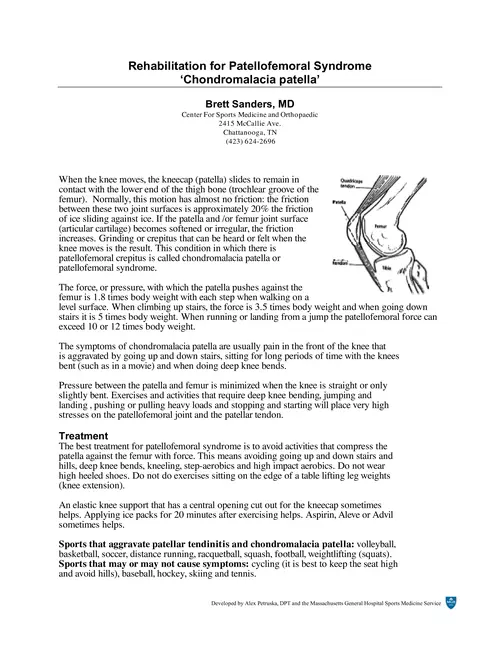
Chondromalacia patella - Center For Sports Medicine & Orthopaedics
A thigh bruise is a bruise (contusion) to the large include rehabilitation exercises and deep tissue. How does it occur? it will take to get better.
adsPart of the document
When the knee moves, the kneecap (patella) slides to remain in
contact with the lower end of the thigh bone (trochlear groove of the
femur). Normally, this motion has almost no friction: the friction
between these two joint surfaces is approximately 20% the friction
of ice sliding against ice. If the patella and /or femur joint surface
(articular cartilage) becomes softened or irregular, the friction
increases. Grinding or crepitus that can be heard or felt when the
knee moves is the result. This condition in which there is
patellofemoral crepitus is called chondromalacia patella or
patellofemoral syndrome.
The force, or pressure, with which the patella pushes against the
femur is 1.8 times body weight with each step when walking on a
level surface. When climbing up stairs, the force is 3.5 times body weight and when going down
stairs it is 5 times body weight. When running or landing from a jump the patellofemoral force can exceed 10 or 12 times body weight. The symptoms of chondromalacia patella are usually pain in the front of the knee that is aggravated by going up and down stairs, sitting for long periods of time with the knees bent (such as in a movie) and when doing deep knee bends.
Pressure between the patella and femur is minimized when the knee is straight or only
slightly bent. Exercises and activities that require deep knee bending, jumping and
landing , pushing or pulling heavy loads and stopping and starting will place very high
stresses on the patellofemoral joint and the patellar tendon.
Treatment
The best treatment for patellofemoral syndrome is to avoid activities that compress the
patella against the femur with force. This means avoiding going up and down stairs and
hills, deep knee bends, kneeling, step-aerobics and high impact aerobics. Do not wear
high heeled shoes. Do not do exercises sitting on the edge of a table lifting leg weights
(knee extension).
An elastic knee support that has a central opening cut out for the kneecap sometimes
helps. Applying ice packs for 20 minutes after exercising helps. Aspirin, Aleve or Advil
sometimes helps.
Sports that aggravate patellar tendinitis and chondromalacia patella: volleyball, basketball, soccer, distance running, racquetball, squash, football, weightlifting (squats). Sports that may or may not cause symptoms: cycling (it is best to keep the seat high and avoid hills), baseball, hockey, skiing and tennis.
Developed by Alex Petruska, DPT and the Massachusetts General Hospital Sports Medicine Service


